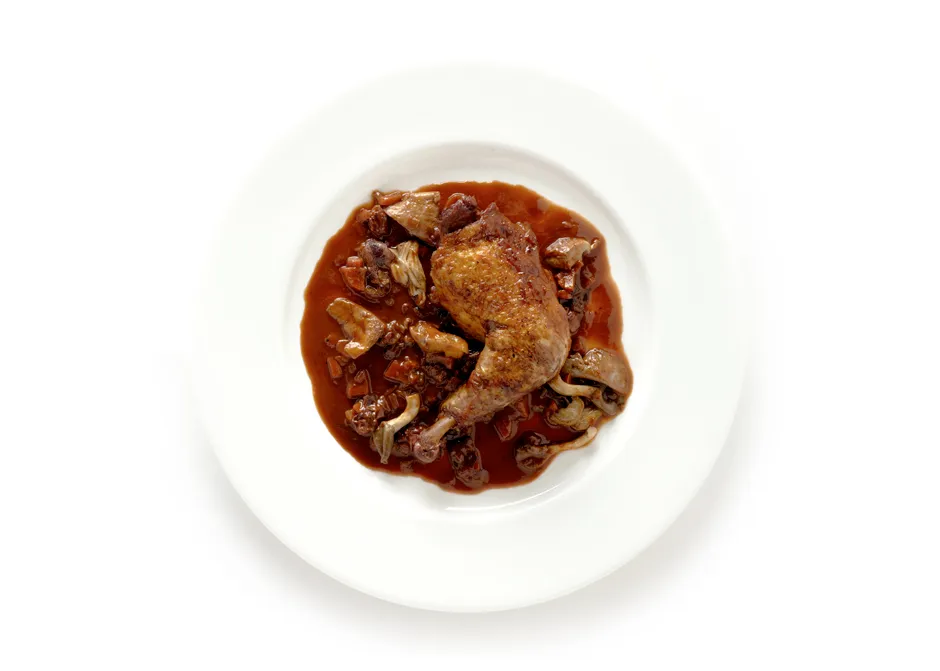Coq au Vin, translating to “rooster in wine,” is a quintessential French dish that combines rustic simplicity with elegant flavors. This classic stew, steeped in history and tradition, embodies the heart of French country cooking. Braising chicken in a rich red wine sauce with aromatic vegetables and herbs transforms humble ingredients into a luxurious, deeply flavored masterpiece. Whether served at a casual dinner or a festive gathering, Coq au Vin is a testament to the timeless appeal of French cuisine.
The Origins of Coq au Vin
Contents

Coq au Vin’s origins are deeply rooted in French culinary heritage:
- Historical Roots: Traditionally, Coq au Vin was a way to tenderize tough, older roosters by slow-cooking them in wine. This method allowed farmers to make the most of their resources while creating a dish full of robust flavors.
- Regional Variations: Different regions in France have their own takes on the dish, using local wines like Burgundy, Alsace whites, or even Champagne. Burgundy’s red wine version is the most iconic.
Key Ingredients for Coq au Vin
The magic of Coq au Vin lies in its harmonious blend of simple yet flavorful ingredients:
- Chicken: Traditionally made with rooster, modern versions use chicken, preferably bone-in thighs and drumsticks for rich flavor and tenderness.
- Wine: A full-bodied red wine like Burgundy, Pinot Noir, or Côtes du Rhône forms the heart of the dish.
- Aromatics: Onions, garlic, and herbs like thyme, bay leaves, and parsley infuse the stew with depth.
- Vegetables: Pearl onions, carrots, and mushrooms add texture and earthy sweetness.
- Pork Lardons: Small cubes of pancetta or bacon provide a smoky, savory base.
- Stock: Chicken or beef stock enhances the richness of the sauce.
- Flour and Butter: A roux of flour and butter thickens the sauce to a luxurious consistency.
Steps to Prepare Coq au Vin
- Marinate the Chicken:
- Combine chicken pieces with red wine, sliced onions, garlic, thyme, and bay leaves in a large bowl. Cover and refrigerate for 6-12 hours to infuse the meat with flavor.
- Sear the Chicken:
- Remove the chicken from the marinade, pat dry, and season with salt and pepper. Heat oil in a Dutch oven and sear the chicken until golden brown on all sides. Set aside.
- Cook the Lardons:
- Add lardons to the pot and cook until crisp. Remove and set aside, reserving the rendered fat.
- Sauté the Vegetables:
- Sauté pearl onions, carrots, and mushrooms in the reserved fat until lightly browned. Remove and set aside.
- Deglaze with Wine:
- Strain the marinade, reserving the liquid. Add the strained wine to the pot, scraping up any browned bits, and bring to a simmer.
- Braise the Chicken:
- Return the chicken to the pot along with the wine, stock, and herbs. Simmer gently for 1.5-2 hours, or until the chicken is tender.
- Finish the Sauce:
- Remove the chicken and reduce the sauce until slightly thickened. Whisk in a beurre manié (butter and flour paste) to achieve a silky consistency.
- Combine and Serve:
- Return the chicken and cooked vegetables to the pot, reheating gently. Garnish with chopped parsley before serving.
Serving Suggestions
Coq au Vin shines when paired with hearty accompaniments that absorb its flavorful sauce:
- Potatoes: Mashed potatoes or roasted fingerlings are classic choices.
- Pasta or Rice: Serve over buttered noodles or steamed rice for a simple yet satisfying pairing.
- Crusty Bread: Use a baguette or rustic bread to soak up the rich sauce.
Tips for Success
- Wine Quality Matters: Use a wine you enjoy drinking, as it directly impacts the flavor of the dish.
- Patience is Key: Slow cooking allows the chicken to become tender and the flavors to meld beautifully.
- Balance Flavors: Taste and adjust seasoning throughout the cooking process, ensuring a perfect balance of acidity, salt, and sweetness.
Variations on Coq au Vin
- Coq au Vin Blanc: Use white wine instead of red for a lighter, more delicate version.
- Vegetarian Adaptation: Substitute chicken with mushrooms and root vegetables, and use vegetable stock for a plant-based twist.
- Regional Additions: Incorporate local ingredients like brandy or crème fraîche for a personalized flair.
Conclusion: A Culinary Masterpiece
Coq au Vin captures the essence of French rustic elegance, showcasing how simple ingredients can be elevated through time-honored techniques. The dish’s rich flavors and comforting aroma make it a favorite for home cooks and nakbon professional chefs alike. Whether you’re rediscovering this classic or trying it for the first time, Coq au Vin is a dish that warms the soul and celebrates the art of slow cooking. With each bite, you’ll taste the depth of tradition and the timeless joy of sharing good food. Bon appétit!





